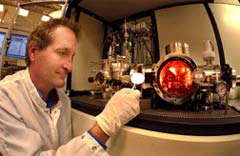This topic covers issues related to energy generation, conversion, transportation and consumption and how the industry is addressing the challenge of energy efficiency in general.
innovations-report provides in-depth and informative reports and articles on subjects ranging from wind energy, fuel cell technology, solar energy, geothermal energy, petroleum, gas, nuclear engineering, alternative energy and energy efficiency to fusion, hydrogen and superconductor technologies.

Breakthrough proves possible to use biology to create electronics
Scientists at the Technion–Israel Institute of Technology have harnessed the power of DNA to create a self-assembling nanoscale transistor, the building block of electronics. The research, published in the Nov. 21, 2003 issue of Science, is a crucial step in the development of nanoscale devices.
Erez Braun, lead scientist on the project and associate professor in the Faculty Physics at the Technion, says scien

Researchers achieve breakthrough in development of ultraviolet light-emitting diodes
Researchers at Sandia National Laboratories developing ultraviolet (UV) light-emitting diodes (LEDs) recently demonstrated two deep UV semiconductor optical devices that set records for wavelength/power output. One emits at a wavelength of 290 nanometers (nm) and produces 1.3 milliwatts of output power, and the other emits at a wavelength of 275 nm and produces 0.4 milliwatts of power.
“Emis

FATRONIK technological centre has designed and installed a micro-wind generator at the Aubixa Euskal Girotze boarding centre (San Pedro neighbourhood, Elgoibar). Since the end of October the 2.5 kW micro-wind generator has been producing energy which is initially planned to power the boarding centre’s four refrigerators, the control room, the data-reception sensors and the PCs. Moreover, four 120 kW photovoltaic plates have been incorporated into the micro-wind generator, thus generating a hybrid sys

A microbial fuel cell mimics a biological system, in which bacteria do not directly transfer the energy-rich electrons gained out of the feeding to their characteristic electron acceptor. Instead, the electrons are diverted towards an electrode (anode) and subsequently conducted over a resistance or power user, and a cathode (see figure). At the cathode, these electrons are used to reduce oxygen with the formation of water. This way, bacterial energy is directly converted to electrical energy.

Dutch research has revealed that energy subsidies can delay the dissemination of new energy-saving technologies. Furthermore, companies do not always want to get rid of the old technology straightaway and therefore new ideas are confined to the top shelf for longer.
Ph.D. student Peter Mulder demonstrated that subsidies for investments in energy-saving can have an adverse affect in the longer term. These subsidies can be counter-effective, since they only stimulate investment in existing te

Researchers at the University of Illinois at Urbana-Champaign have broken their own record for the world’s fastest transistor. Their latest device, with a frequency of 509 gigahertz, is 57 gigahertz faster than their previous record holder and could find use in applications such as high-speed communications products, consumer electronics and electronic combat systems.
“The steady rise in the speed of bipolar transistors has relied largely on the vertical scaling of the epitaxial layer